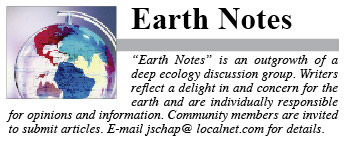Earth Notes: Where are the battle lines?

By Frank Daggett
“We have not lost the battle. If given the chance, nature will reconquer its rights and will prevail.” So said Anne Larigaudiere, the executive secretary of the United Nations Intergovernmental Science Policy Panel on Biodiversity and Ecosystem Services when it published, in May, its report on the risk of widespread species extinctions. The quote reflects two problems: One for the environment, and one for the environmental movement.
The report claims that nearly a million kinds of plants and animals are at risk of extinction, possibly by the middle of this century. But a 12 percent species extinction rate is only one measure, and not the best for measuring the impact. A better illustration is what naturalist Michael McCarthy termed "the moth snowstorm" in his book of the same name. He recalls nighttime drives in Britain in his youth, when moths in the headlights looked like the snowflakes of a blizzard. By the time his book was published in 2016, the moth snowstorm was no longer a thing in the U.K. Here in Maine, it’s been a long time since I had to stop at a gas station on a summer night just to clean my headlights and windshield. In Europe, four-fifths of all flying insects have disappeared since the fall of the Berlin Wall in 1989, despite comparatively strict E.U. laws about pesticide use. I’m not aware of a similar study for Maine, only the cleanliness of my auto to go by. But it occurs to me that I’m more likely to see an owl or other night bird than before, and wonder, am I seeing them because they’re no longer obscured by the moth snowstorm? Maine Audubon reports that owls have been in decline, and so are other birds and bats that, unlike owls, feed on flying insects. Still, owls would be affected as their prey, small rodents, decline because they can’t dine on the eggs and larvae of flying insects. Fish and amphibians are likewise affected. The U.N. report estimates that 40 percent of amphibian species are near extinction; it did not report on marine or aquatic species.
Loss of biomass and species diversity is just one problem for the environment included in the U.N. report. A problem for the environmental movement is reflected in the quote above. It’s remarkable for fighting words like battle and conquest to come from an official of the world’s peace-keeping organization. It gives one pause that the enemy against which Lariguadiere hopes nature will prevail is humankind. It isn’t that she is a misanthrope; she also notes that the loss of biodiversity is “a truly global and generational threat to human well-being.” She’s reflecting the fractured nature of society, and of the nature of our species, which needs little provocation to argue even when we face a common threat, as the bickering over the coronavirus response shows once again. No doubt there’s at least one Malthusian rejoicing that nature is culling the population of “those people” who just want to be like the rest of us who are consuming 15 percent more per capita since 1980. I haven’t heard it yet, but then I’ve been limiting my consumption of social media and talk radio. Those who attempt to calm fears by saying that the mortality rate of coronavirus is less than half that of the killer flu of 1918 seem to ignore that medicine has advanced a hundredfold since then. May we live to tell the tale and reverse the decrease in biodiversity with a decrease in ideology. Instead of putting forward novel moral theories such as that nonhuman nature has rights (what rights does COVID-19 have?), may we draw on our human intellect and compassion to fulfill our unique responsibility as stewards of nature, which includes each other.

